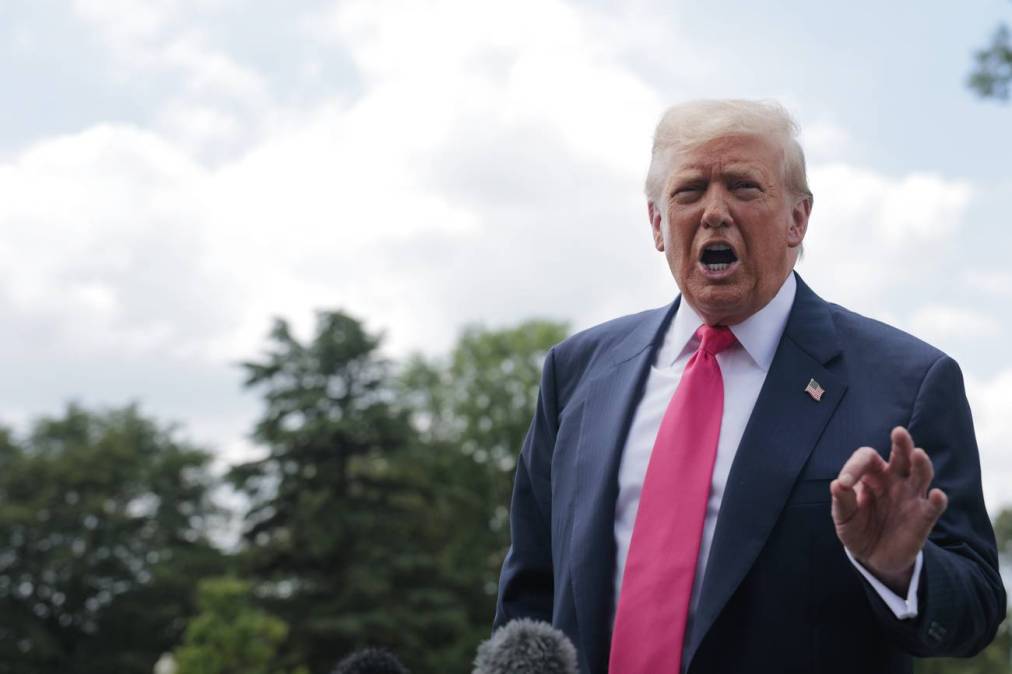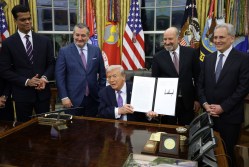Defeated state AI moratorium finds new life in Trump’s AI Action Plan

The AI Action Plan the Trump administration released Wednesday tells the story of a glittering prize of unsurpassed worth in a winner-take-all competition that the United States absolutely must win. The 28-page document sketches out a three-pronged strategy based on accelerating innovation, building up the nation’s AI infrastructure and leading on international AI diplomacy to become the global vanguard in a technological domain the White House claims will simultaneously usher in “industrial revolution, an information revolution, and a renaissance.”
A quote from President Donald Trump included in the plan sets the stage for the magnitude of the endeavor. “Breakthroughs in these fields have the potential to reshape the global balance of power, spark entirely new industries, and revolutionize the way we live and work,” he says, also noting the grave national security implications should the United States fall behind on AI.
Several policy analysts interviewed by StateScoop said the Trump administration’s plan for winning the AI race is thorough and contains many well-considered proposals — it “meets the moment,” said Hodan Omaar, a senior policy manager with the Information Technology and Innovation Foundation, a Washington think tank. The plan calls for more data centers and electrical power to fuel the machines that run the algorithms, greater support for AI-powered science and scientific datasets and a national initiative to ensure key industries — like health care, energy and agriculture — are using AI effectively.
But in the administration’s zeal to win the AI race, its plan also explicitly threatens to undermine the large and growing corpus of state AI law. The plan notes that AI is “far too important to smother in bureaucracy at this early stage,” and that any states with AI regulations that are “burdensome” or “unduly restrictive” risk losing their “AI-related” federal funding, a potentially encyclopedic category of work that no analyst was able to clearly define.
“I think what the administration is trying to do is really from its soapbox make clear that it wants to prevent a patchwork of state regulations,” Omaar said. “It supports the idea that a patchwork could stifle innovation, it would fragment the national AI landscape. It wants to prevent that.”
The plan renews a threat to state autonomy defeated in Congress this month when lawmakers voted against language, championed by Sen. Ted Cruz, R-Tex., in the budget reconciliation act that would have imposed a 10-year moratorium on states enforcing their AI laws, which target everything from AI-fueled pornography to deepfakes used in political campaigns. Sen. Marsha Blackburn, R-Tenn., initially considered supporting some version of the moratorium before reversing course and bringing the rest of the Senate with her. “This provision could allow Big Tech to continue to exploit kids, creators, and conservatives,” she said in a statement explaining her reversal.
Travis Hall, director for state engagement with the Washington think tank Center for Democracy and Technology, said Trump’s AI plan effectively puts the moratorium back in play, but with the added niggle that it contains ambiguities to be animated by the interpretations of numerous federal agencies.
“The AI moratorium essentially said no state laws. That’s not good, but it’s clear,” Hall said. “What the AI Action Plan creates is an arbitrary standard by which any discretionary grant program could potentially be reviewed and revoked.”
Revoked funding could include a broad range of programs, he said, such as the $45 billion Broadband Equity, Access and Deployment, or BEAD, program, or education funding, which could be implicated thanks to an executive order last April that calls for greater use of AI by educators and “our Nation’s youth.” The plan’s lack of clarity in some areas may be intentional, Hall said.
The plan also calls on the Federal Communications Commission, a telecommunications agency, to evaluate whether state AI regulations “interfere with the agency’s ability to carry out its obligations and authorities” as described by the Communications Act.
“This is a massive power grab that, because these things occur over a telecommunications network and are a part of communications, the FCC has jurisdiction,” Hall said.
Cody Venzke, a senior policy counsel with the American Civil Liberties Union, said the plan’s details are vague, and it will only be after federal agencies begin implementing the plan that states will know whether their AI regulations are considered by the White House to be overly burdensome to private industry.
“The Communications Act was passed in 1934, and it gives the FCC regulatory authority over things like cellular airwaves or landline telephones,” Venzke said. “It doesn’t give the FCC jurisdiction over social media or TV programming — or artificial intelligence. It’s not clear how artificial intelligence is going to interfere with the FCC’s authority, and even if it did, the FCC wouldn’t have jurisdiction to preempt state laws there anyway.”
States have introduced hundreds of pieces of legislation attempting to rein in AI use, from government’s own uses of the technology to arcane intersections with multimedia copyright law or laws designed to protect people from stalkers. But recent analysis by the National Council of State Legislatures shows that, in aggregate, the largest push is behind regulating private industry.
Democratic and Republican lawmakers have sometimes found common cause in advancing AI regulations as they’ve tallied a growing number of ways the technology threatens to reinforce discriminatory practices or expose children to new online threats. Legislation advancing through California’s legislature that would put tighter controls on “companion” chatbots was inspired by the suicide of a 14-year-old Florida boy who’d formed an unhealthy relationship with a chatbot.
“There’s a very deep concern here, which is that this administration has been happy to claw back funds from schools, from cities, from all sorts of programs, often without giving reason, and often in a thinly veiled political move,” Venzke said. “This gives added impetus for all sorts of federal agencies to do the same, to pull funds for political reasons from state programs they don’t like, under the cause it’s interfering with the advancement of American AI.”






